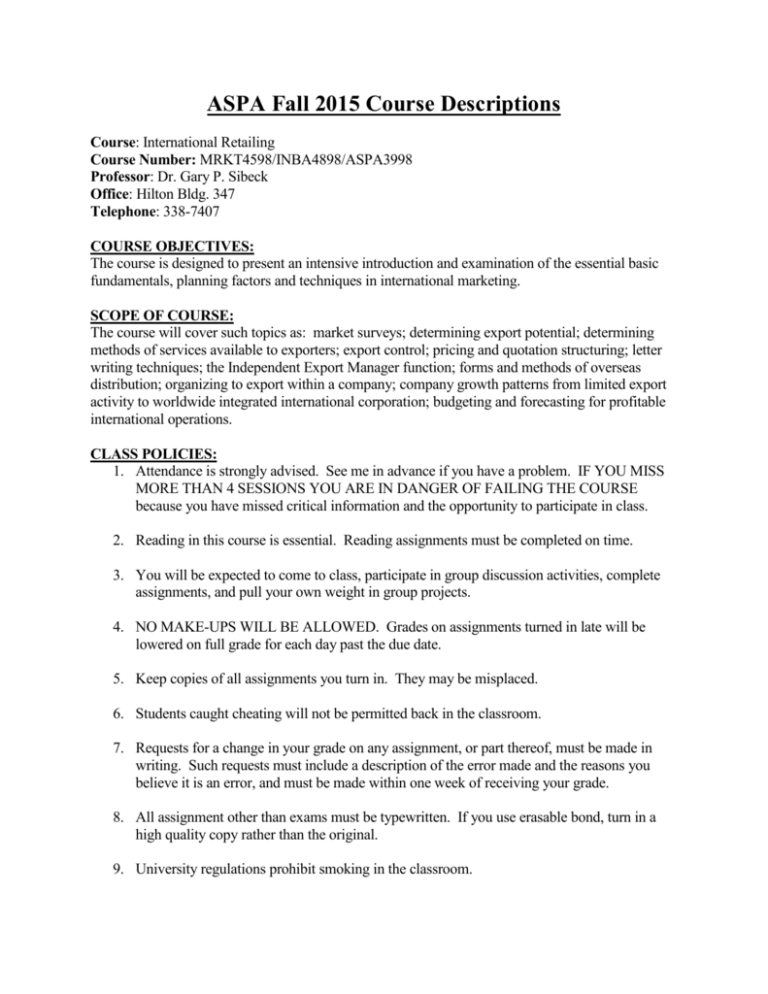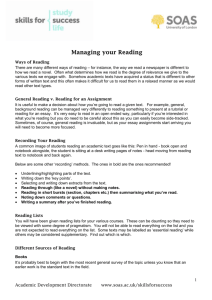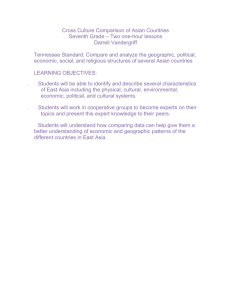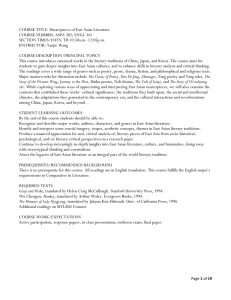ASPA 2015 Fall Course Descriptions
advertisement

ASPA Fall 2015 Course Descriptions Course: International Retailing Course Number: MRKT4598/INBA4898/ASPA3998 Professor: Dr. Gary P. Sibeck Office: Hilton Bldg. 347 Telephone: 338-7407 COURSE OBJECTIVES: The course is designed to present an intensive introduction and examination of the essential basic fundamentals, planning factors and techniques in international marketing. SCOPE OF COURSE: The course will cover such topics as: market surveys; determining export potential; determining methods of services available to exporters; export control; pricing and quotation structuring; letter writing techniques; the Independent Export Manager function; forms and methods of overseas distribution; organizing to export within a company; company growth patterns from limited export activity to worldwide integrated international corporation; budgeting and forecasting for profitable international operations. CLASS POLICIES: 1. Attendance is strongly advised. See me in advance if you have a problem. IF YOU MISS MORE THAN 4 SESSIONS YOU ARE IN DANGER OF FAILING THE COURSE because you have missed critical information and the opportunity to participate in class. 2. Reading in this course is essential. Reading assignments must be completed on time. 3. You will be expected to come to class, participate in group discussion activities, complete assignments, and pull your own weight in group projects. 4. NO MAKE-UPS WILL BE ALLOWED. Grades on assignments turned in late will be lowered on full grade for each day past the due date. 5. Keep copies of all assignments you turn in. They may be misplaced. 6. Students caught cheating will not be permitted back in the classroom. 7. Requests for a change in your grade on any assignment, or part thereof, must be made in writing. Such requests must include a description of the error made and the reasons you believe it is an error, and must be made within one week of receiving your grade. 8. All assignment other than exams must be typewritten. If you use erasable bond, turn in a high quality copy rather than the original. 9. University regulations prohibit smoking in the classroom. COURSE FORMAT: Lectures, discussions, case analysis, and presentations. GRADES: GRADES WILL BE DETERMINED ACCORDING TO THE FOLLOWING SCHEDULE: First Exam 1/3% Final Exam 1/3% Term Paper 1/3% READING MATERIAL: International Retailing 2nd Edition Brenda Sternqist Fairchild Publication Course Title: Economic and Political Issues in Contemporary Asia (Fall 2015) Course Number: ASPA 3500 01 Section Times/Days: MWF 3:00pm-4:00pm Instructor: Jason Chiu Core Attribute: Understanding Human Behavior COURSE OBJECTIVES: This course deals with the political economy of contemporary Asia, with particular focus on countries such as China and Japan. As the largest economies of Asia, these two nations have extraordinary influence over Asia’s future; they also offer important political and economic lessons for the rest of the world. Course topics include: East Asian economic miracles; the Asian Financial Crisis of 1997; the “Lost Decades” of Japan; economic reforms in China and India; economic convergence; East Asian demographic decline; the primacy of national sovereignty; human rights; and the remembrance of World War Two. In addition to the two books assigned, additional academic articles will be assigned throughout the quarter to ensure student understanding of the class topic. This course fulfills the Understanding Human Behavior (EHBV) Core Attribute. STUDENT LEARNING OUTCOMES: By the conclusion of this course students should be able to: Describe the economic and political development of China, Japan and India in modern times; Analyze how the three economies function today and the interaction of their political and economic systems; Employ basic concepts from economics and political science to explain how a real-world political economy functions; Evaluate the usefulness and the limitations of Western economic and political concepts in understanding major non-Western economies and societies. PREREQUISITES/RECOMMENDED BACKGROUND: There is no prerequisite for this course. REQUIRED TEXTS: Nina Hachigian, Debating China: The U.S.-China Relationship in Ten Conversations (Oxford: Oxford University Press, 2014) Additional reading assignments can be accessed via the public domain, or made available to students via the instructor’s own personal website. COURSE WORK EXPECTATIONS: Students will be expected to come to class on time with pre-assigned readings already completed. To ensure that students are keeping up with the reading material and are able to connect the readings with the lecture component, students will be quizzed regularly, asked to write weekly short paragraph essays, and complete a 10-12 page research paper based on extensive scholarly research via academic databases. Course: Theology and Science Course Number/Section: THST 3238.1/ASPA 3998-09 Course Time: R 4:30-7:00 Instructor: Kumar, Jay Cores Covered: INT: Faith & Reason Flags Covered: n/a *Please note that this is a sample course description from a previous semester and is subject to change. COURSE DESCRIPTION/PRINCIPAL TOPICS: Why are we here? What is the meaning of existence? How do humans fit into the universe? Is religious experience contrary to scientific thought? These existential questions on the nature of our human experience have been explored from competing perspectives by the two dynamic forces of religion and science. The course investigates how scientific inquiry and spiritual faith might express complementarity and achieve unity. Topics spanning quantum theory, health sciences, cosmology, ecology and cognitive neuroscience will be investigated via this integral approach from both religion and science. The course surveys an array of issues, noted thinkers, theologians and scientists from both Eastern and Western religions. Class discussion will explore how religion and science simultaneously clash, coexist and influence each other. STUDENT LEARNING OUTCOMES: Identify the historical, philosophical and cultural factors that have led to the traditional divide between science and religion. Engage in a critical and intellectual dialogue in the convergence of science and religion. Articulate ways in which science and religion relate and provide examples of such relationships in various fields. Comprehend general scientific claims and relate these to theology and various spiritual traditions Examine the role that science and religion currently interact has played in contemporary media and politics in shaping socio-cultural perspectives and in 21st century contexts. Cultivate analytic, writing, and research skills in the completion of individual research projects on a topic pertaining to the course. PREREQUISITES/RECOMMENDED BACKGROUND: Although there is no specific prerequisite, students should have some prior studies in science and/or religion. REQUIRED TEXTS: Future of Man. Teilhard de Chadrin, Pierre. The Great Partnership: Science, Religion, and the Search for Meaning. Sacks, Jonathan. God Is Not Dead: What Quantum Physics Tells Us about Our Origins and How We Should Live. Goswami, Amit Brain, Body & Being. Kumar, Jay COURSE WORK/EXPECTATIONS: As this is an upper-division course, the reading load will be greater than in lower division courses. Students should be expected to dedicate on average 3-4 hrs a week to reading assignments from both text and online materials. This does not include independent time put into student research paper or study for quizzes and exams. Additionally, students will be expected to produce a well-researched final paper. Class participation and group presentation 10% of final grade Quizzes 10% of final grade Personal Reflective Project 10% of final grade Research Paper 25% of final grade Midterm Exam 20% of final grade Final Exam 25% of final grade Course: Hinduism, Jainism, Yoga Course Number/Section: THST 3283/ASPA 3098-07 Course Times: MW 2:20-3:50 Instructor: Faculty TBD Core Area: INT: Faith & Reason Flags Covered: Engaged Learning COURSE DESCRIPTION/PRINCIPAL TOPICS: This course will examine key ideas from the Vedas and Upanisads, the ethics of Jainism, and the spiritual practices of Yoga. GENERAL STUDENT LEARNING OUTCOMES FOR FAITH & REASON COURSES: 1. Identify the beliefs and practices of major religious traditions, including Christianity and especially Catholic Christianity. 2. Understand the richness and complexity of theological and religious traditions, especially in light of contemporary issues and diverse voices 3. Examine and evaluate critically the diverse ways in which religious beliefs and practices change across time and space. 4. Integrate theological and religious questions and problems through the careful study of a major theological or religious thinker or theme. 5. Develop theological and religious comprehension and reflection through the acquisition of a research language or engaged learning. PREREQUISITES/RECOMMENDED BACKGROUND: Must have Junior Standing Course: Buddhism Course Number: THST 3282.1/ASPA 3098-06 Course Times: M W 2:20 to 3:50 Professor: Christopher Key Chapple (Doshi Professor of Indic & Comparative Theology) Contact: 3763 University Hall; cchapple@lmu.edu; 310-338-2846 Core Area: INT: Faith & Reason Flags Covered: Engaged Learning, Writing COURSE DESCRIPTION: Buddhism originated in India more than 2300 years ago. From India it spread throughout Asia and in the 20th Century became a well-known practice throughout the world. In this course we will study the life of the Buddha and the foundational teachings that he conveyed, especially the four noble truths (duhkha, trsna, nirodha, marga) and his no-self assessment of the human condition. In addition to these early teachings that characterize the Theravada School, we will also look at Mahayana Buddhism, which flourished in China, Korea, and Japan, and Vajrayana Buddhism, found primarily in Tibet. A focal theme this semester will be death and dying in Buddhist traditions. We will take field trips to Buddhist centers in Los Angeles, read and discuss primary texts, and see videos on the Buddhist faith. COURSE EXPECTATIONS: Students will be expected to take two examinations and complete two papers. The first paper of approximately five pages will be on a group field experience. Student learning communities will be formed. Each group will make a presentation to the class and each student will submit her or his own paper on the assigned topic. Two groups will work on field visits. Two groups will participate in Zen sessions and prepare presentations on the Philip Kapleau book. Two groups will prepare participate in Vipassana sessions and prepare presentations on the book Wide Awake. One group will focus on the relationship between Buddhism and the elevation of ecological awareness. The second paper in on a topic of the student’s choice. Length: approximately ten to twelve pages. One might choose to research and write about the role of Buddhism in war, perhaps including citation of the work of Thich Nhat Hanh during the time of the Vietnam conflict, and reflections on how your direct experience of Buddhism through meditation and/or field trips affirmed or brought into question your assumptions regarding Buddhism and war and peace. Or you may have a family member with a sustained practice that you might want to research. Or you might have an interest in a particular form of Buddhism or a particular Buddhism philosopher. For instance, one might want to do biographical research on the Dalai Lama or the topic of Buddhism and Ecology or the Jataka Tales or the Heart Sutra or a philosophical topic such as Emptiness and Compassion as expressed in the Bodhicaryavatara. Each paper will include footnotes/endnotes and a bibliography of at least seven items, only three of which may be websites. Consult with the university research librarians as you develop your bibliography. LEARNING OUTCOMES: By the end of the course, students will be familiar with the history and primary teachings of Buddhism as found in the Theravada, Mahayana, and Vajrayana schools. They will be familiar with the geographic spread of Buddhism and be aware of the ongoing presence of Buddhism in Los Angeles. They will learn about Buddhist attitudes toward death and dying as well as the environment. Course: The United States and the Pacific World Course Number: History 1401/APAM 1118/ASPA 1998 Section Times/Days: Section 01 Tu & Th 11:20 a.m.-12:50 p.m. & Section 02 Tu & Th 1:00 p.m.-2:30 p.m. Instructor: Professor Constance Chen Core Area: Satisfies the Historical Analysis and Perspectives (EHAP) Requirement COURSE DESCRIPTION/PRINCIPAL TOPICS: Since the eighteenth century, when merchant ships shuttled back and forth between New York and Canton, the United States has had significant exchanges and encounters with the Pacific World. Using race, class, and gender as prisms, this lower-division course will explore the ways in which the development of American histories, cultures, and societies have been transformed by Asians, Pacific Islanders, and Asian Americans from the earliest contact to the twenty-first century within transnational and comparative frameworks. Topics to be discussed will include international politics and the enactment of immigration legislations, nativist sentiments, the formation of nationalist ideals, labor and work, changing ethnic enclaves, and racial and gender discourses, among others. Students will analyze these themes and issues in light of the "opening" of the Pacific markets, the Westward expansion, and American participation in international conflicts as well as other historical events. STUDENT LEARNING OUTCOMES: To acquire an understanding of the political, cultural, and socioeconomic factors that have shaped the development of the United States in light of exchanges with the Pacific World from the colonial era to the twentieth-first century; to explore and discuss primary sources and secondary documents in order to synthesize and critically evaluate the information presented to develop independent points of view on issues including immigration policies, international relations, and racial discourses. PREREQUISITES/RECOMMENDED BACKGROUND: None. REQUIRED TEXTS: Readings will include a variety of primary documents such as institutional records, newspaper accounts, and personal letters as well as scholarly monographs and articles. COURSE WORK/EXPECTATIONS: Students will be evaluated by their attendance and participation, formal writing assignments, inclass essay exams as well as other exercises designed to delve further into the class topics and themes. Course: Asian Civilizations Course: ASPA 2100 Section times/days: T/TH 2:40-4:10 Instructor: Charlotte D’Evelyn COURSE DESCRIPTION/PRINCIPAL TOPICS: This course is a survey of Asian civilizations from ancient times to the pre-modern era through a study of history, literature, art, philosophy and music in the region. We will examine the beliefs, values, institutions, personalities, events, and forms of creative expression that contributed to the distinctive civilizations of Asia. The course begins with a brief survey of the dynamic civilizations of Central Asia and then moves to explore regions of India, China, Japan, Korea, and Southeast Asia. This semester’s focus will be on a study of peoples and cultures of ancient and pre-modern Asia through a study of their artistic expressions – particularly through visual art and the belief systems that are expressed through art. STUDENT LEARNING OUTCOMES: 1. Use visual art and other historical records to DOCUMENT how cultures and major civilizations in Asia influenced one another and changed over time. 2. TRACE important historical events and individuals that shaped the early history of Asia. 3. CREATE an original project based on course material and students’ own interests and passions. 4. Use clear and structured writing to COMPOSE an original idea or argument. 5. COMMUNICATE in clear speech and writing and be able to discuss how history is tied to a web of various interrelated factors including geography, belief systems, artistic practices, political and social hierarchies, as well as inter-regional dynamics. PREREQUISITES/RECOMMENDED BACKGROUND: No prerequisite courses. Some background knowledge of Asian history and culture will be helpful. REQUIRED TEXTS: Ebrey, Patricia Buckley, and Anne Walthall. 2013. Pre-Modern East Asia: A Cultural, Social, and Political History. Volume 1, Volume 1. Belmont, Calif: Wadsworth. Golden, Peter B. 2011. Central Asia in World History. New York: Oxford University Press. Ricklefs, M. C. 2010. A New History of Southeast Asia. Houndmills, Basingstoke, Hampshire: Palgrave Macmillan. Walsh, Judith E. 2011. A Brief History of India. New York: Facts On File. COURSE WORK/EXPECTATIONS: Graded components include: class participation, quizzes, two midterms, and a final project. This course covers roughly 1,500 years of history across the largest continent in the world. Students are required to maintain active engagement with the readings and lectures throughout the semester in order to perform well on exams. Quizzes are given once or twice a week to check for comprehension and thoroughness on the readings. Class sessions will consist of lectures, videos, and discussion. The final project will include any topic of the student’s choosing, as long as it is related to the culture and civilization of Asia. Projects will involve research and a written essay, but can also involve a creative component such as a film, costume design, piece of visual art, musical composition, documentary, lesson plan, service project, or any other concept of the student’s design. Some creative projects, such as films and dance, are often best completed in groups. Course: Popular Culture in East Asia Course Number: ASPA 3970 Core Area: Integrations: Interdisciplinary Connections Section Times/Days: MWF 10:00-10:50 Instructor: Charlotte D’Evelyn COURSE DESCRIPTION/PRINCIPAL TOPICS: This course examines popular culture and identity formation in Japan, Korea, and China through a study of television, print media, film, and popular music. Course units will focus specifically on: (1) Japanese manga and anime; (2) Chinese martial arts film; and (3) Korean dramas and popular music. We explore how these cultural products, having emerged largely through the combination of traditional and global forms of culture, have in turn profoundly affected popular culture around the globe. Using an interdisciplinary approach to the study of culture, this course challenges students to understand how popular media forms in Asia not only reflect social values and norms, but also challenge and reconstitute them with crucial implications for gender, ethnicity, national identity, and transnationalism. STUDENT LEARNING OUTCOMES: 1. IDENTIFY the significance of popular culture as a medium to represent social groups and define group and individual identity. 2. DEMONSTRATE the ways that popular culture may maintain or resist political norms, hierarchies, and prejudices. 3. UTILIZE a wide variety of disciplinary approaches to the study of popular culture, including the fields of media studies, gender studies, cultural studies, political science, and ethnomusicology. 4. INTEGRATE multiple disciplinary approaches into an original research project on a topic related to East Asian popular culture and identity. 5. CREATE an original argument based on evidence from a variety of media forms. 6. Use clear and structured prose to COMMUNICATE how historical shifts, political and social hierarchies, and local-global dynamics have affected forms of popular culture in Japan, Korea, and China. PREREQUISITES/RECOMMENDED BACKGROUND: No prerequisite courses. Some background knowledge of Japan, China, and Korea will be helpful. REQUIRED TEXTS: All course readings will be posted on blackboard. COURSE WORK/EXPECTATIONS: Graded components are: class participation, weekly reading responses, group presentations and discussion leading, midterm exam, final exam, final project Students should budget **at least 4-6 hours of time** for readings, reading responses, and class discussion preparation each week. Course: Modern Asia Course Number: HIST 1800 ASPA 1998 Section Times/Days: T&R 8:00-9:30 (Section 1), 9:40-11:10 (Section 2) Instructor: Sun-Hee Yoon Core Area: EHAP Flags Covered: Writing COURSE DESCRIPTION/PRINCIPAL TOPICS: This course introduces Modern East Asian history through the voices of those who made it. As a broad survey of East Asian history from 1600to the present, it examines the major developments, institutions, and forces that shaped the identity of East Asians. While following a basic chronological organization, the course will use names such as empire-building, economic expansion, nationalism, popular culture, and gender to explore that history. The course will pay more attention to the conflicts, interactions, and mutually constitutive experiences of the peoples of China, Japan, Korea and Euro-American powers instead of treating the histories of individual national in isolation. STUDENT LEARNING OUTCOMES: Students will learn how to read critically by studying a variety of primary source materials. They will develop a basic cultural and historical vocabulary, and improve their understanding of today’s China, Japan, and Korea. In addition, students will improve their skills in writing essays that use primary source as evidence in support of argument. PREREQUISITES/RECOMMENDED BACKGROUND: None REQUIRED TEXTS: 1. Patricia B. Ebery, et al., Modern East Asia: From 1600: A Cultural, Social and Political History, (Any edition) Houghton-Mifflin, 2006. 2. Hildi Kang, Under the Black Umbrella: Voices from Colonial Korea, 1910-1945, Cornell University Press, 2001. 3. Jonathan Spencer, Mao Zedong: A Life, Penguin, 2006. 4. Primary Source Reader COURSE WORK/EXPECTATIONS: In this course, there are two examinations (a mid-term and a final), two papers, and a map quiz. Course: Masterpieces of East Asian Literature Course Number: ASPA 3200; ENGL 3341 Section Times/Days: TR 1:00-2:30p.m. Instructor: Yanjie Wang Core Attribute: Information Literacy COURSE DESCRIPTION/PRINCIPAL TOPICS: This course introduces students to some classic works in the literary traditions of China, Japan, and Korea, spanning from antiquity up to the early 19th century. This course aims for students to gain deeper insights into East Asian cultures as well as to enhance skills in literary analysis. The readings cover a wide range of genres including philosophical texts, poetry, prose, drama, fiction, and film. Major masterworks for discussion include The Classic of Poetry, Dao De Jing, Zhuangzi, Tang poetry and Tang tales, The Story of the Western Wing, Journey to the West, Haiku poems, Noh drama, The Tale of Genji, and The Story of Ch’unhyang etc. We will not only explore various ways of appreciating and interpreting East Asian literary works but also examine the contexts that established these works’ cultural significance: the traditions they built upon and their social and intellectual contexts. Moreover, treating these works as living cultural assets, we will discuss some adaptations they generated in the contemporary era. STUDENT LEARNING OUTCOMES: Describe major works, authors, characters, and genres in East Asian literature. Interpret major imagery, tropes, aesthetic concepts, and themes in East Asian literary traditions. Demonstrate deeper insights into East Asian literature, culture, and society. Produce in-depth analysis of East Asian literary works from socio-historical, psychological, and/or literary-critical perspectives in both oral and written forms. Assess the legacies of East Asian literature in a reflective manner. PREREQUISITES/RECOMMENDED BACKGROUND: There is no prerequisite for this course. All readings are in English translation. This course fulfills the English major’s requirements in Comparative in Literature. REQUIRED TEXTS: Genji and Heike, translated by Helen Craig McCullough. Stanford University Press, 1994. Wu Chengen, Monkey, translated by Arthur Waley. Evergreen Books, 1994. The Memoirs of Lady Hyegyong, translated by Jahyun Kim Haboush. Univ. of California Press, 1996. Additional readings on MYLMU Connect COURSE WORK/EXPECTATIONS: Active participation; response papers, in-class presentation; midterm exam; final paper. Course: The Meditative Gaze: Dao and Film Course Number: PHIL. 4810 & FTVS 499 & ASPA 3998.08 Section Times/Days: R 4:30-7:00 Instructor: Robin Wang & Sue Scheibler COURSE DESCRIPTION/PRINCIPAL TOPICS: This course brings two distinctive disciplines, philosophy and film theory together into a coherent discourse. The focus of the class is on the philosophical question most often posed as the mindbody problem and the various ways that media texts have addressed and articulated this issue, specifically through the adoption of a meditative gaze as a philosophically charged stylistic approach. Using Daoist philosophical texts as a foundation for understanding the questions, students will use these texts to think through the ways that film and television have engaged these questions cinematically; that is, through the formal elements of film language (editing, camera, lighting, and sound). During the course, students will apply what they are learning about the specificities of the cinematic medium to arrive at a definition of the meditative gaze and the ways that this gaze theorizes the relationship between mind and body. STUDENT LEARNING OUTCOMES: By the end of this course students will know and understand: The fundamental concepts of mind and body as expressed in Daoist philosophical texts The basic elements of film’s formal language (editing, camera, sound) as well as the basic theoretical approaches employed in film analysis (Marxist cultural studies, psychoanalysis, phenomenology, continental philosophy, and semiotics) The difference between reading a media text formally and analytically and using it to illustrate an idea The various ways that philosophers have thought about cinema as a way of doing philosophy, especially philosophers arguing for thinking about film as a form of philosophy The various ways that scholars have applied Daoist principles to media texts PREREQUISITES/RECOMMENDED BACKGROUND: None REQUIRED TEXTS: Daodejing, Translated with illuminating explanation by Hans-Georg Moeller, (Open Court, 2007). Zhuangzi, translated by Brook Ziporyn (Hackett, 2008). Yinyang: The Way of Heaven and Earth in Chinese Thought and Culture (Cambridge University Press, 2012) Reader for Film COURSE WORK/EXPECTATIONS: Two papers Final exam Reading quizzes Class participation Course: Introduction to the Media and Politics of Asia Course Number: ASPA 3600 01 Section Times/Days: M 4:20-7:20pm Instructor: Prof. Thomas Plate COURSE DESCRIPTION/PRINCIPAL TOPICS: This is an introductory course into issues of the contemporary news media and politics of Asia. This survey will include analyses of selected nations in East Asia, Southeast Asia and South Asia, with a possible special look at China via courtesy presentations. The class will examine the general hypothesis that each nation’s media system is driven by its particular political, economic, cultural and religious history. We survey the region’s leading countries to gain an understanding of the factors that shape the values, procedures and media institutions in Asia. The role of an increasingly assertive middle class will be analyzed as a factor of special importance. So will the impact of so-called Asian Values and of the social-media technology of the Internet. As the course proceeds, we will compare various media systems and their political and governmental wellsprings. Class discussions will emphasize an effort to understand Asia’s news media systems on their own terms, and in comparison to other models, while not insisting on the Western/American/Adversarial media model as the ideal or even as a global normative standard. Students will be required to conduct a Skype-type interview in the Asia Media office (UH 3319) for video presentation to the class on a media topic of the region. STUDENT LEARNING OUTCOMES: Students will become familiar with the major contemporary issues of the Asia Pacific region through an interdisciplinary examination of issues of media, governance, economic development and technology in leading countries. Students will reflect comparatively on the various countries’ media values (and media/political structure) in comparison to the familiar (the U.S.) As a result of this course, it is hoped and indeed expected that the student will emerge with a sense of helpful foundational self-confidence in coming to terms with and understanding the issues and problems of Asia, the world’s fastest-rising region. This course aims to make the student a more informed citizen in our globalizing world. PREREQUISITES/RECOMMENDED BACKGROUND: An intense and responsible interest in the world and the geopolitical future of the 21st century is preferred. Mainly, students interested in the workings of the international news media, and/or in a general introduction to the politics and media of Asia, and/or in aspects of the relationship between Asia and America, as that relationship becomes manifestly more important during their lifetimes. REQUIRED TEXTS: ONE: CAN ASIANS THINK? By Kishore Mahbubani. Marshall Cavendish Publishers, Singapore. 4th Edition with 5 new essays edition (December 8, 2011) ASIN: B006IJJHZG (either from campus bookstore or amazon.com e-book) TWO: IN THE MIDDLE OF THE FUTURE TOM PLATE ON ASIA by Tom Plate. Marshall Cavendish Editions, Singapore. 2014. ISBN : 978-981-4408-63-9 THREE: Professor will provide selected articles from the “Journal of East Asian Studies”; from “Media Asia,’ the scholarly publication of the Asia Media Information Centre at Nanyang Technological University in Southeast Asia (Media Asia is a quarterly magazine that serves as an important platform for relevant information, commentaries and book reviews on the latest trends and issues in the field of communication and information; and from the ASIA JOURNAL OF COMMUNICATION (the Asian Journal of Communication is a joint, peer-reviewed, international research publication of the Asian Media Information and Communication Centre and the School of Communication and Information of the Nanyang Technological University of Singapore. COURSE WORK/EXPECTATIONS: Students are expected to attend every lecture, read assigned materials and prepare to discuss readings. There will be a final exam or final paper and 10 in-class quizzes on the assigned reading. The semester project will be the Skype interview.








